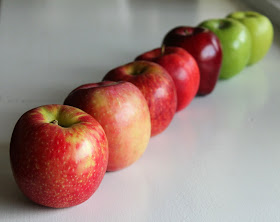 |
| From left to right: Honeycrisp, Fuji, Jonagold, Gala, Red Delicious, Granny Smith, Golden Delicious |
Growing up, I remember three varieties of apples at the grocery store: Red Delicious and Golden Delicious for snacking and Granny Smith for cooking. And that was it. The only other apple I ever got back then was a Spitzenberg, which grew on a tree in our backyard.
Today, there are a lot more varieties of apples easily accessible at the traditional grocery store, upscale food shops and farmers markets. Back in 1989, 25 years ago, Red Delicious, Golden Delicious and Granny Smith together accounted for 66 percent of U.S. apple production, but by 2011, their share had fallen to 43 percent (according to U.S. Dept. of Agriculture Economic Research Service). Red Delicious in particular has taken a tumble: production of the shiny red apple peaked in 1994, when it accounted for half of all U.S. apples. Seventeen years later, it's still the most popular apple, but accounts for less than a fourth of U.S. production as the availability of varieties such as Gala, Fuji and Honeycrisp have steadily risen.
This is good for the consumer. More varieties of apples at the store means there's more to choose from and enjoy. But how do you choose?
I set up a tasting of seven common apple varieties, including the three familiar ones from my youth, plus four that have become popular in recent years: Fuji, Gala, Honeycrisp and Jonagold. All of these varieties are readily available at grocery stores such as Safeway and Whole Foods (the two stores where I purchased them). I chose only apples grown in the United States, and five of the varieties (the ones from Whole Foods) came from Washington State, America's #1 apple-growing state.
Chris and I tasted all of them over dinner one night in the order presented below. Here are our thoughts on their flavor and texture, augmented with facts from the
U.S. Apple Association (you can read about many other apple varieties on their site as well).
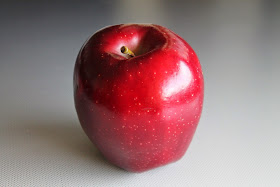 |
| Red Delicious: beautiful and very sweet, but lacking in flavor. |
Red Delicious. Long the most popular apple in the U.S., Red Delicious' reputation has tarnished a bit of late, as consumers have begun to favor more flavorful and firmer-textured apples. Expecting to not really care for it, I was pleasantly surprised that the apple really wasn't that bad. Sure, it wasn't one of our favorites, but it had a great texture that wasn't at all mealy. Where the apple fell down was on taste. The Red Delicious apple was very sweet--the sweetest of the bunch--and really nothing else. There just wasn't that much flavor there. It was beautiful too look at though, a deep garnet red, with a curvy shape unique to western Red Delicious apples, which are described as having "feet" in comparison to most apples that are more rounded.
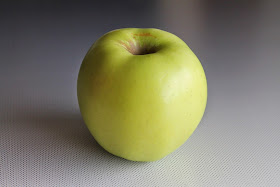 |
| Golden Delicious: crisp with a nice balance of sweet and tart. |
Golden Delicious. This apple was discovered in 1890 on the East Coast and originally named Mullin's Yellow Seedling before acquiring its current name in 1916. I really liked this apple's texture, which was noticeably crisper than the Red Delicious. Flavor-wise, it wasn't as sweet as Red Delicious and was even a little sour, although not nearly as tart as its friend Granny Smith below. It really is a nice happy medium between two, making it a great apple for snacking on raw. Golden Delicious, along with Granny Smith, is one of the few most common varieties of apples that aren't red.
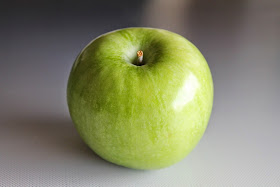 |
| Granny Smith: very tart and firm. |
Granny Smith. Believe it or not, the Granny Smith really is named for "Granny Smith," specifically Maria Ann "Granny" Smith, an orchardist who cultivated the apple in Australia. This apple is well known among bakers, as it is a favorite for apple pies. It's tartness is ideal for cooking, allowing the cook to control the level of the dish's sweetness by adding more or less sugar. For many years, Granny Smith was our go-to snack apple too. I love its tartness. And man is it tart! The most sour apple of this group by far. I love it with a little peanut butter, as it really brings out the peanut butter's sweetness. The apply has a very firm texture, which is almost chalky (not in a bad way).
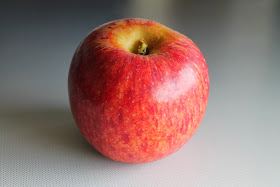 |
| Jonagold: wonderful, juicy flavor and somewhat firm. |
Jonagold. This variety was one I found at Whole Foods and not one that we eat often. That might change after this tasting, for I was really taken with this apple. It has a full flavor nicely balanced between sweet and tart and very juicy. It's pretty firm, although not quite as firm as Golden Delicious. It shouldn't come as a surprise that the texture is similar, since Jonagold is a hybrid between a Jonathan apple and a Golden Delicious, created in 1968. Although most of these apples had white flesh, the Jonagold's was markedly more yellow. So far, this one
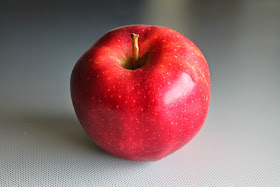 |
| Gala: lacking in flavor and crispiness. |
Gala. Production-wise in the United States, Gala apples are now second to Red Delicious, a remarkable rise, considering that Galas were pretty much unknown until the mid '90s. Frankly, their popularly is a bit lost on us, as this was our least favorite apple we sampled. Except for the Red Delicious, this apple had the least interesting flavor, but we actually liked Red Delicious's texture more, as the Gala's mouthfeel was a bit mealy. I do, however, like this apple for cooking: it's wonderful in the
Triple Smoky Apple-Blue Cheese Crostini that I posted to my site today.
 |
| Fuji: firm texture and balanced flavor. |
Fuji. It's no coincidence the Fuji apple shares its name with Japan's best-known mountain; the apple was created there, a hybrid between Red Delicious and Ralls Janet, a cultivar from Virginia. Like the Gala, this apple enjoyed a meteoric rise in popularity. It first appeared in the United States in the 1980s, and by 1998 it was the third most-produced variety. The Fuji has a nice firm texture, similar to that of the Granny Smith, but not at all sour like that apple. The Fuji's flavor was nicely balanced. It's not a very bold apple, but it's certainly not a bad apple either.
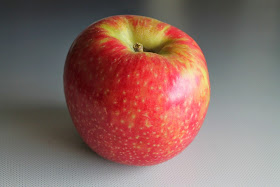 |
| Honeycrisp: Juicy and crisp; less sweet than expected. |
Honeycrisp. Is there an apple with a better name than "honeycrisp?" It's rather genius, positively conveying its sweetness and texture. Interestingly, the Honeycrisp wasn't the sweetest apple in this bunch, trailing both Red Delicious and Jonagold. It's texture though is fabulous, a wonderful combination of juiciness and crispness. This texture is a reason Honeycrisp is becoming a rather popular apple for baking (I like to use a combination of Granny Smith and Honeycrisp in my pies). Later this week, I'll be featuring a baked apple dessert that uses Honeycrisp apples.
Verdict: The Jonagold apple was my overall favorite, a juicy apple with wonderful apple flavor that's nicely balanced between sweet and tart. Texture-wise, Honeycrisp was king, although Golden Delicious was second. All of the apples were good though--even our least favorites had their strong points. Now it's your turn. Tell me what your favorite apples are and whether you agree with my assessment of these varieties.









No comments:
Post a Comment